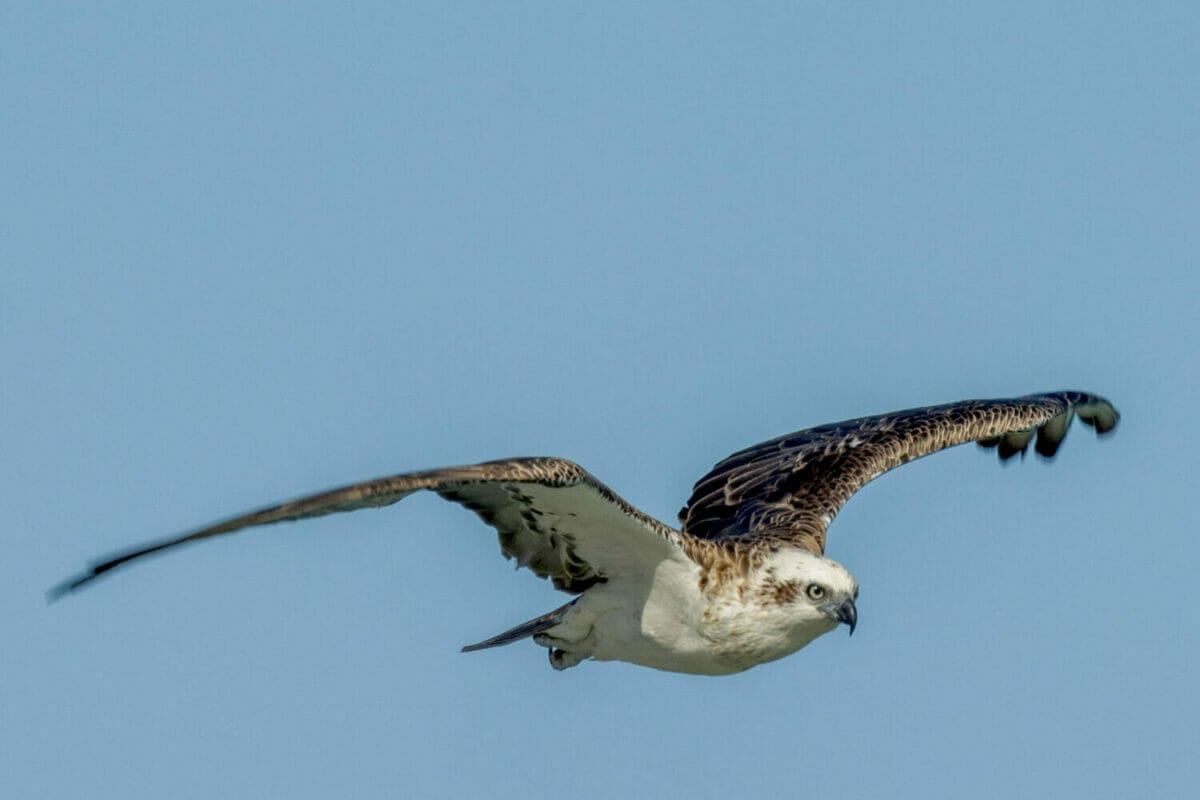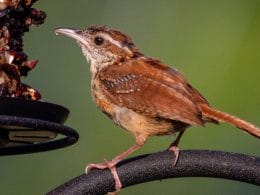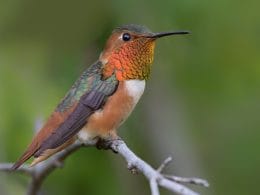Ospreys are famous for their hunting prowess. An Osprey is an excellent fisher and they are often found fishing near lakes, coastal waterways, rivers, and ponds. So what time of day do osprey hunt?
Nesting Osprey tend to hunt early in the morning right around dawn. This is because their young are often hungry in the morning, and it is the best time to catch fish.

Do Osprey Hunt at Night?
While Ospreys could hunt at dusk, they will typically not set out on a hunt during the night. Ospreys are known as diurnal hunters and rest at night. Ospreys use their incredible vision and their strong, sharp talons for hunting, but not at night.
Although the Osprey family is varied, all within the family are diurnal and will only hunt during the day.
The male Osprey will typically do most of the hunting, especially when there are babies to fend for. The best time to look for Ospreys is during midsummer when Ospreys will have to hunt more for their young chicks. While these raptors will hunt at any time of the day, the early morning and late evening will be best.
Keen birdwatchers could view these impressive raptors along any water body, including estuaries, rivers, reservoirs, small ponds, and even fish farms.
How Do Ospreys Hunt?

When trying to figure out what time of day do osprey hunt, you first need to find an Osprey. Ospreys are generally easy to spot. They will soar over the water before launching a lethal dive into the water. The dive can be from 10m or even from 40m. Birdwatchers will have the best chance on calm, overcast days when the water is clear.
A mature Osprey will typically have a successful dive after two or three dives. On the other hand, a juvenile will not generally have a successful hunt until they are ready to join the migration. Therefore, males will be the primary hunters for the family and will remain in the nest area until the migration.
Author Note: This makes for excellent birdwatching. Birdwatchers can identify a nest site and remain in the area watching the Osprey family’s daily antics until the offspring join the migration.
An Osprey’s fleet is equipped with gripping pads that help them hold onto their prey once they have targeted it. With their gripping pads, their prey is expertly plucked from the water. The Osprey is also equipped with curved claws to help the raptor carry the fish back to their nest. An Osprey will sometimes have to travel far distances with their prey, and they use the wind to help them. To combat any resistance from the wind, the Osprey will carry the fish headfirst.
Osprey vs. Eagles
It is typical for the Bald Eagle (photo on the left) and Osprey (on the right) to be confused. To avoid this confusion, you can identify them by their whiteheads with a black eyestripe. This striking eye stripe runs down their face as well, and their white underbellies will give their species away as well. It is common for ospreys and eagles to be in the same hunting grounds.
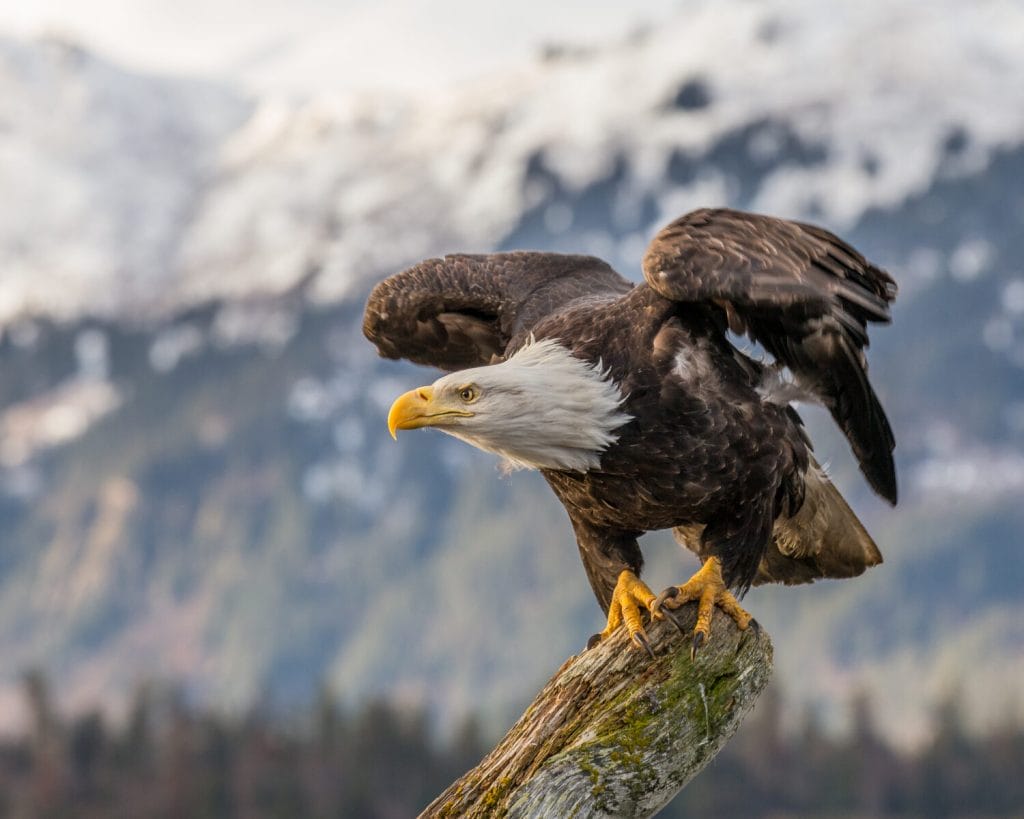
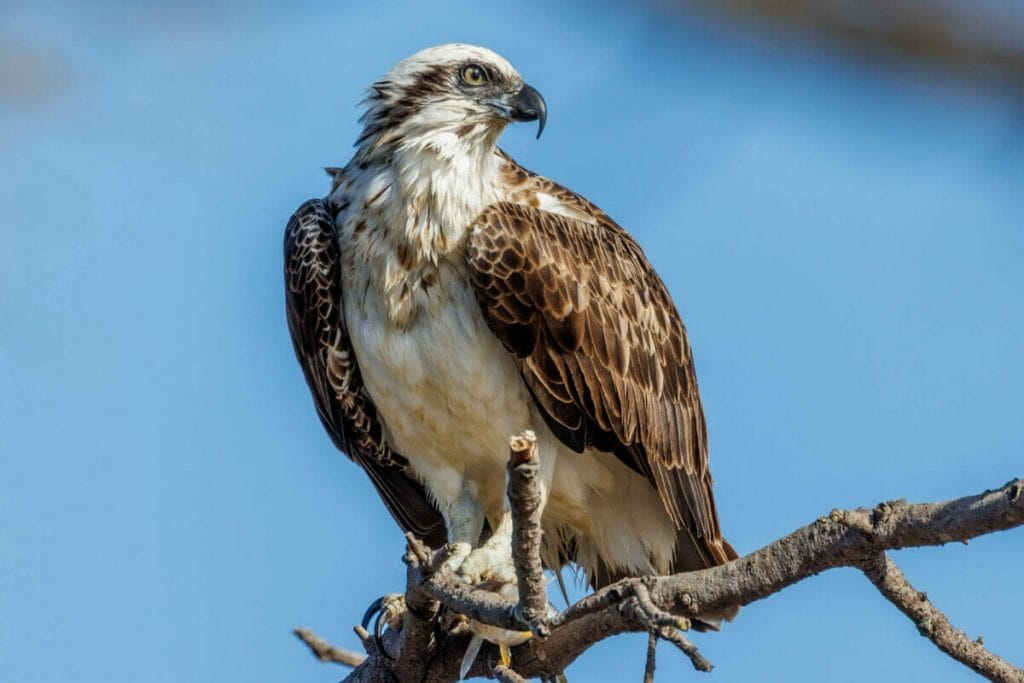
For this reason, fortunate birdwatchers may witness the two species battling for food. As the more aggressive raptors, eagles will often fight the Osprey and force it to let go of the captured prey. The eagle will typically swoop in to catch the stolen prey. The time of day eagles hunt is similar to what time of day osprey hunt.
Osprey Population
Unlike most species, the Osprey might enjoy the encroachment of the human habitat. These raptors do not seem to be too shy as they will happily use human habitat as their nesting area. Ospreys build large nests from sticks and sod. Their nests are often constructed on telephone poles and antennas. Preservationists have begun to erect poles with nesting platforms to help the species survive endangerment. Despite seeming comfortable with human development, the Osprey has been on the endangered list since the 50s.
There is a more subtle danger to the Osprey species survival, and that is chemical pollutants. These pollutants are a grave danger to Ospreys, as chemicals like DDT can thin the eggshells. This is dangerous for an Osprey species survival. Thanks to conservation efforts, the Osprey population is becoming once again. However, some areas still see low levels of Osprey.
Osprey Reproduction
Although there are many different members in the Osprey family, almost all are migratory birds. Almost all Ospreys breed in the North during the warmer months and migrate to the South as the winter begins to creep in. A pair of mating osprey will usually have three eggs in their nests.
This number of eggs is no accident, as we all know there are no accidents in nature. Three eggs are helpful for incubation, as the eggs can retain the heat easier. However, not all three eggs will hatch simultaneously. This staggered hatching results in chicks that will be stronger than others. This means that the younger baby chicks will struggle when there is a lack of food.

Do Ospreys Only Eat Fish?
The primary component of an Osprey’s diet is fish. They catch live fish from the water, and it is clear that an Osprey is physically designed for this. An Osprey’s strong claws and lengthy talons are ideal for snatching and holding onto slippery fish as they fly back to their nests.
But, there are some instances where other creatures become an easy meal. Ospreys have been known to prey on frogs, snakes, and eels.
Where Do Ospreys Go at Night?

Female Ospreys will remain at their nests with the young chicks or eggs at night. However, if the nest is empty, then the pair will sleep elsewhere at night. Similar to eagles, the Osprey pair will roost in a tree nearby at night.
What Makes Osprey Such Good Fishers?
Excellent Eyesight
Like most birds of prey, the Osprey has excellent eyesight. That is because they have many receptors in their eyes. This high density increases an eye’s acuity.
Secondly, they have what can best be described as a ‘third eyelid.’ This membrane is transparent and offers protection to the eye when a bird penetrates the water’s surface. Have you ever looked into a pool of water and noticed how things appear distorted? This is because of refraction. The Osprey can also compensate for this and can identify the fish’s exact position underneath the water.
Plumage
The Osprey has an oily plumage that helps prevent its feathers from retaining water. If an osprey targets a large fish, it may have to put up quite a fight underneath the water. If they did not have this oily plumage, the bird could become waterlogged as they struggle to lift the fighting fish into the air.
Ospreys also spend time preening their feathers. They are kitted out with a gland on their backside, this gland secretes oil, and the birds spread this oil over their feathers to enhance their water resistance.
Coloration
Thanks to an osprey’s signature white underside, a fish cannot easily distinguish an osprey from a brightly lit sky.
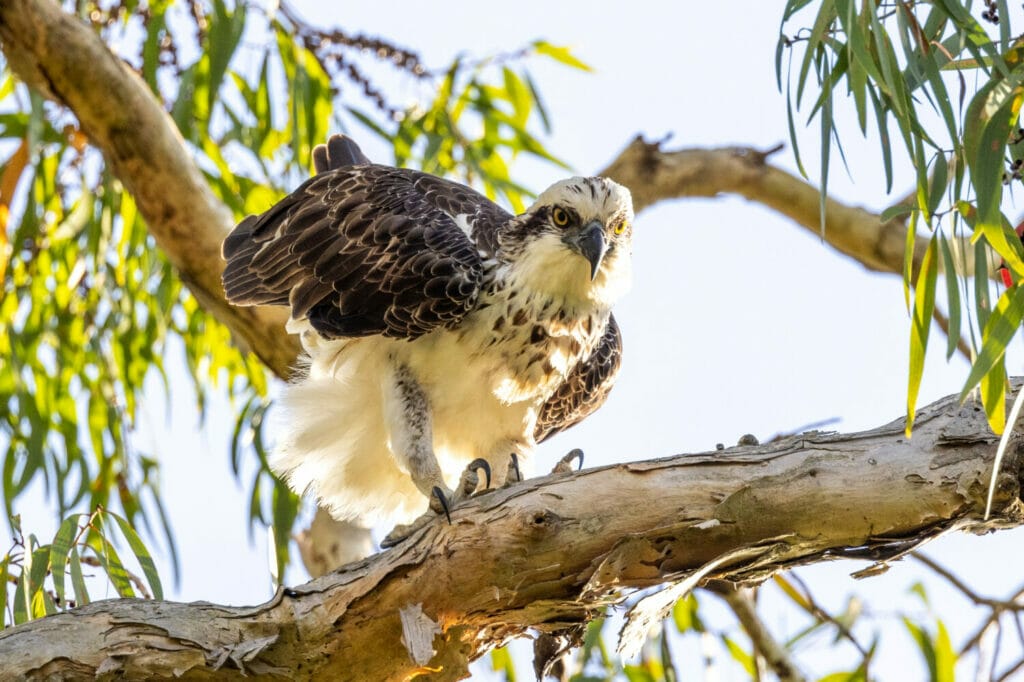
Lanky Legs
Ospreys have long legs, which help them grab fish without submerging themselves under the water. Thanks to these lanky legs, ospreys have been known to catch fish as deep as three and a half feet deep.
Their Feet and Talons
Thanks to their large, scaly feet and razor talons, the Osprey can grab slimy fish and hold on tight. But the real prize comes in the form of tiny spines underneath their toes. These spines referred to as spicules, give an osprey an extra advantage when holding onto the wet fish. And that’s not all.
The Osprey’s toes are opposable. This allows for enhanced maneuverability as they hold their prey and fly back to their nests.
Where to Find Osprey in the Winter
The Osprey can be found on every continent in the world, except for Antarctica. In the wintertime, birdwatchers can find ospreys throughout the state of Florida, Mexico, and South America.
Interesting Osprey Facts
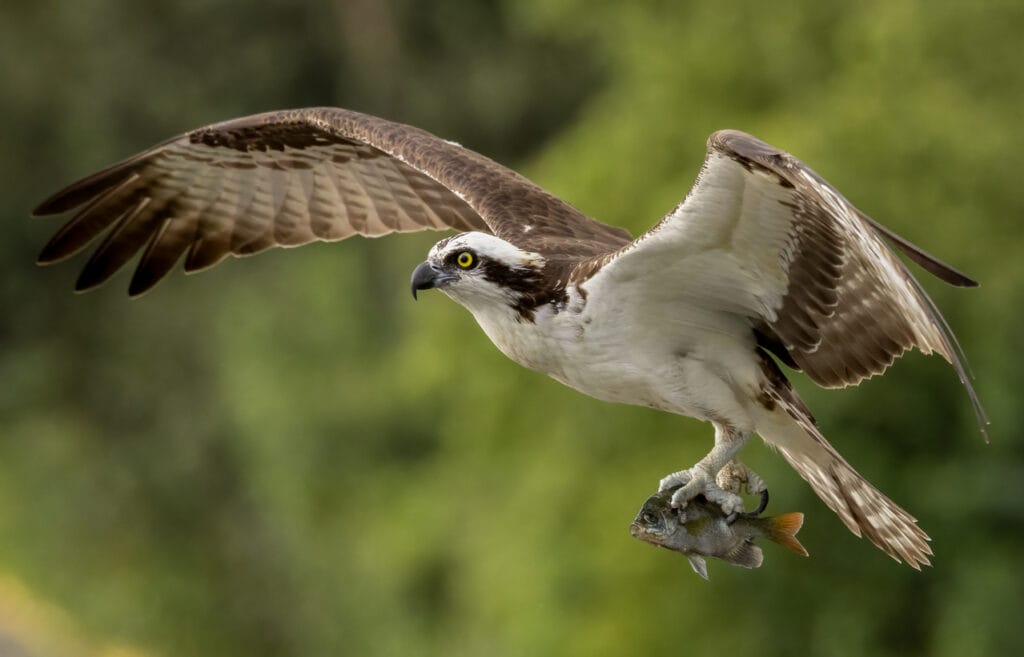
Author Note: The Osprey may be one of the lesser-known birds of prey, but it remains a fascinating species for avid birdwatchers. Here are some facts you may find interesting about the Osprey:
- A juvenile osprey is highly unlikely to hunt for its own prey before its first migration season. And on that note, a young osprey will join its first migration on its own, without the parents. While the parents will also join the migration, they will not lead the young. The juveniles will have their instincts to guide them as they separate from their parents for the first time.
- Ospreys return to the same wintering ground as well as the same breeding ground year after year.
- Osprey are often chased by bald eagles and Great back-backed gulls. The ospreys are often chased by these raptors when hunting, especially when they have caught fish. The Osprey will be forced to let go of their prey, with the eagle swooping in to catch the stolen catch.
Conclusion
The Osprey is not usually the first on every birdwatcher’s list, often overshadowed by the larger eagle. But once you see an osprey in action, it will be tricky not to be enchanted by their antics.
What is your favorite bird of prey to watch? Remember, when you see a nesting pair of ospreys, it is likely that they will remain in the area until the migration season. What’s more, the birds will return to the same breeding area year after year. We hope you enjoyed this article on what time of day do osprey hunt.
Fly high friends!
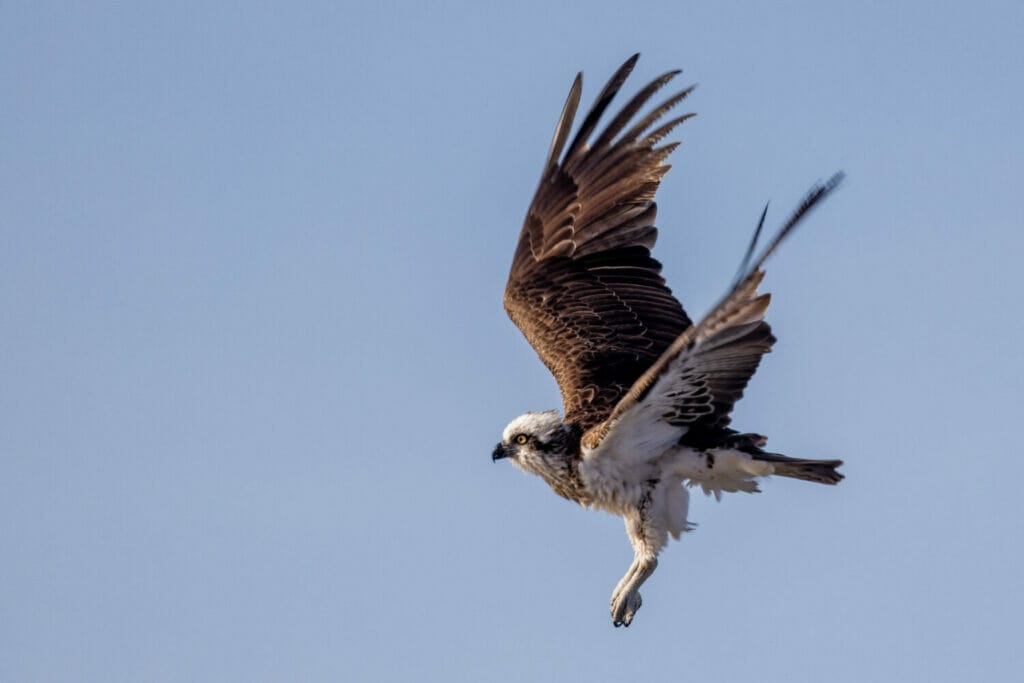
FAQ
They are special because they are the only raptor that dives into water to catch fish. Also they have toes that are reversible so they can grip onto their catch as they fly.
Nothing really is going to take on a fully grown Osprey. However, eagles and larger hawks may attempt to take chicks from the nest.
They sure are. If an Osprey nests somewhere dangerous then a permit can be issued to move the nest.




